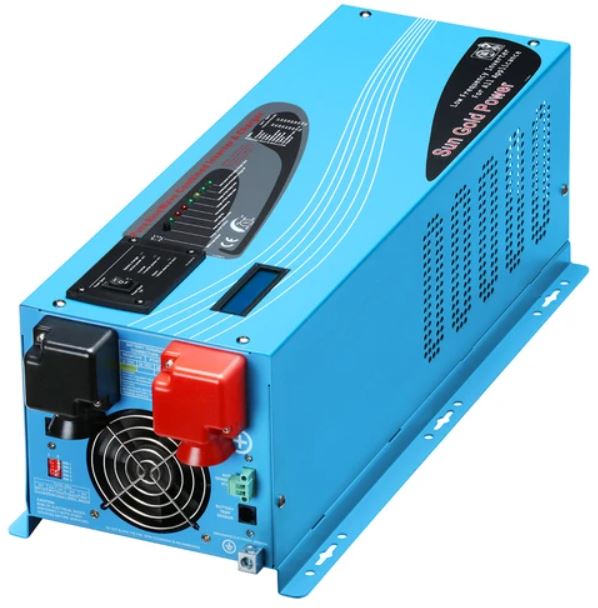
SunGoldPower 3000W DC 12V Peak 9000W Inverter Charger
About SunGoldPower
A corporation focused on renewable energy, SunGoldPower was founded several decades ago. With solar panels, low-frequency inverters, solar inverters, and other green energy equipment, we are dedicated to offering green power solutions. SunGoldPower manufactures all of its products in compliance with the strictest quality standards.
Important Safety Information
WARNING!
This manual contains important instructions for all LFP Inverter/Charger models that shall be followed during installation and maintenance of the inverter.
General Safety Precautions
- Do not expose the Inverter to rain, snow, spray, bilge, or dust. To reduce the risk of hazard, do not cover or obstruct the ventilation openings. Do not install the Inverter in a zero-clearance compartment. Overheating may result. Allow at least 30CM(11.81 inches) of clearance around the inverter for airflow. Make sure that the air can circulate freely around the unit. A minimum airflow of 145CFM is required.
- To avoid a risk of fire and electronic shock. Make sure that existing wiring is in good electrical condition; and that wire size is not undersized. Do not operate the Inverter with damaged or substandard wiring.
- This equipment contains components that can produce arcs or sparks. To prevent fire or explosion do not install in compartments containing batteries or flammable materials or in locations that require ignition-protected equipment. This includes any space containing gasoline-powered machinery, fuel tanks, joints, fittings, or other connections between components of the fuel system.
See Warranty for instructions on obtaining service.
- Do not disassemble the Inverter/Charger. It contains no user-serviceable parts. Attempting to service the Inverter/Charger yourself may result in a risk of electrical shock or fire. Internal capacitors remain charged after all power is disconnected.
- To reduce the risk of electrical shock, disconnect both AC and DC power from the Inverter/Charger before attempting any maintenance or cleaning. Turning off controls will not reduce this risk
CAUTION: Equipment damage
The output side of the inverter’s AC wiring should at no time be connected to public power or a generator. This condition is far worse than a short circuit. If the unit survives this condition, it will shut down until corrections are made. Installation should ensure that the inverter’s AC output is, at no time, connected to its AC input.
Warning: Limitations On Use
SPECIFICALLY, PLEASE NOTE THAT THE LFP SERIES INVERTER/CHARGER SHOULD NOT BE USED IN CONNECTION WITH LIFE SUPPORT SYSTEMS OR OTHER MEDICAL EQUIPMENT OR DEVICES.
Precautions When Working with Batteries
- If battery acid contacts skin or clothing, wash immediately with soap and water. If acid enters the eye, immediately flood the eye with running cold water for at least 20 minutes and get medical attention immediately.
- Never smoke or allow a spark or flame in the vicinity of the battery or engine.
- Do not drop a metal tool on the battery. The resulting spark or short-circuit on the battery of another electrical part may cause an explosion.
- Remove personal metal items such as rings, bracelets, necklaces, and watches when working with a lead-acid battery. A lead-acid battery produces a short-circuit current high enough to weld a ring or the like to metal, causing a severe burn.
- To reduce the risk of injury, charge only rechargeable batteries such as deep-cycle lead acid, lead-antimony, lead calcium gel cell, absorbed mat, NiCad/NiFe, or Lithium battery. Other types of batteries may burst, causing personal injury and damage.
Introduction
General Information
This Series Pure Sine Wave Inverter is a combination of an inverter, battery charger, and AC auto-transfer switch into one complete system with a peak conversion efficiency of 88%. It is packed with unique features and it is one of the most advanced inverter/chargers in the market today. It features power factor correction, sophisticated multi-stage charging, and pure sine wave output with unprecedentedly high surge capability to meet the demanding power needs of inductive loads without endangering the equipment. For the regular model, when utility AC power cuts off(or falls out of acceptable range), the transfer relay is de-energized and the load is automatically transferred to the Inverter output. Once the qualified AC utility is restored, the relay is energized and the load is automatically reconnected to the AC utility.
The LFP Series Inverter is equipped with a powerful charger of up to 110Amps (depending on model). The overload capacity is 300% of continuous output for up to 20 seconds to reliably support tools and equipment longer Another important feature is that the inverter can be easily customized to Battery priority via a DIP switch, this helps to extract maximum power from battery in renewable energy systems. Thus, the LFP Series Pure Sine Wave Inverter is suitable for Renewable energy systems, Utility, RV, Marin, and Emergency appliances. To get the most out of the power inverter, it must be installed, used, and maintained properly. Please read the instructions in this manual before installing and operating.
Application
- Power tools–circular saws, drills, grinders, sanders, buffers, weed and hedge trimmers, air compressors.
- Office equipment – computers, printers, monitors, facsimile machines, scanners.
- Household items – vacuum cleaners, fans, fluorescent and incandescent lights, shavers, sewing machines.
- Kitchen appliances – coffee makers, blenders, ice markers, toasters.
- Industrial equipment – metal halide lamp, high–pressure sodium lamp.
- Home entertainment electronics – television, VCRs, video games, stereos, musical instruments, satellite equipment.
Features
- Smart Remote Control (RMT)
- Designed to Operate under a Harsh Environment
- DC Start & Automatic Self-Diagnostic Function
- Compatible with Both Linear & Non-Linear Load
- Easy to Install & Easy to Operate & Easy to Solve
- Low DC Voltage Supports Home and Office Appliances
- Powerful Charge Rate Up to 120Amp, Selectable From 0%-100%
- High Efficiency Design & “Power Saving Mode” to Conserve Energy
- Battery Priority Mode, Designates the Inverter-Preferred UPS Configuration
- 13 Vdc Battery Recover Point, Dedicated for Renewable Energy Systems
- 8 pre-Set Battery Type Selector plus De-sulphation for Totally Flat Batteries
- 4-step Intelligent Battery Charging, PFC (Power Factor Correction) for Charger
- 8 ms Typical Transfer Time Between Utility & Battery, Guarantees Power Continuity
- 15s Delay Before Transfer when AC Resumes, Protection for Load when Used with Generator
Mechanical Drawing
- LFP 1KW to 1.5KW Models
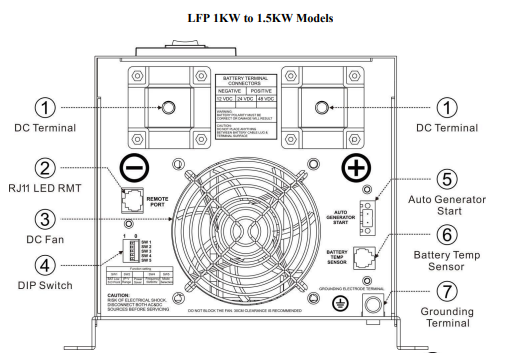
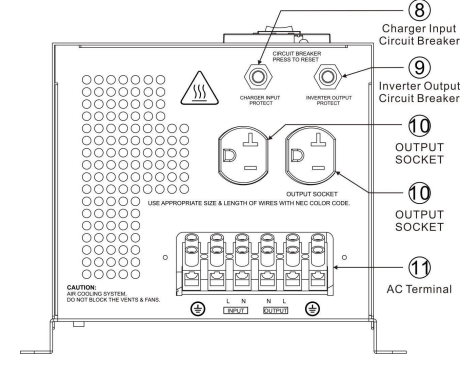
- LFP 2KW to 4KW Models

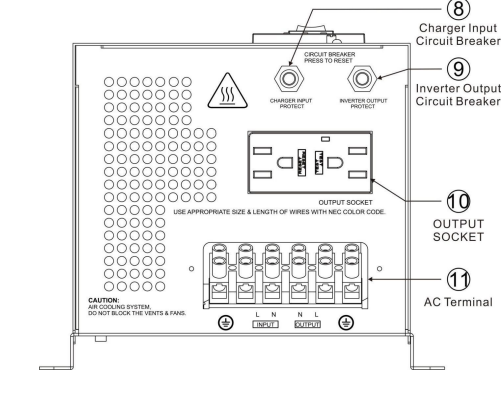
- LFP 5KW to 6KW Models
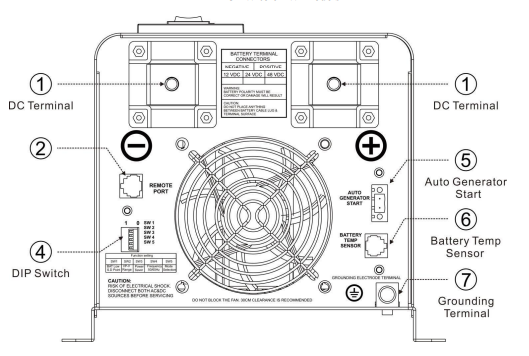

Electrical Performance
AC Charger
LFP Series is equipped with an active PFC (Power Factor Corrected) multistage battery charger. The PFC feature is used to control the amount of power used to charge the batteries to obtain a power factor as close as possible to 1. Unlike other inverters whose max charging current decreases according to the input AC voltage, the LFP series charger can output max current as long as the input AC voltage is in the range of 164-243VAC (95-127VAC for 120V model), and AC freq is in the range of 48-54Hz(58-64Hz for 60Hz model). The LFP series inverter is with a strong charging current of 120Amp (for 4KW,12V), and the max charge current can be adjusted from 0%-100% via a liner switch at the right of the battery type selector. This will be helpful if you are using our powerful charger on a small-capacity battery bank. Fortunately, the liner switch can effectively reduce the max charging current to 20% of its peak. Choosing “0” in the battery type selector will disable the charging function. There are mainly 3 stages:
Bulk Charging: This is the initial stage of charging. While Bulk Charging, the charger supplies the battery with a controlled constant current. The charger will remain in Bulk charge until the Absorption charge voltage (determined by the Battery Type selection) is achieved. The software timer will measure the time from A/C start until the battery charger reaches 0.3V below the boost voltage, then take this time as T0 and T0×2 = T1.
Absorb Charging: This is the second charging stage and begins after the absorb voltage has been reached. Absorb Charging provides the batteries with a constant voltage and reduces the DC charging current to maintain the absorb voltage setting. In this period, the inverter will start a T1 timer; the charger will keep the boost voltage in Boost CVmode until the T1 timer has run out. Then drop the voltage down to the float voltage. The timer has a minimum time of 1 hour and a maximum time of 12 hours.
Float Charging: The third charging stage occurs at the end of the Absorb Charging time. While Float charging, the charge voltage is reduced to the float charge voltage (determined by the Battery Type selection*). In this stage, the batteries are kept fully charged and ready if needed by the inverter. If the A/C is reconnected or the battery voltage drops below 12Vdc/24Vdc/48Vdc, the charger will reset the cycle above. If the charge maintains the floating state for 10 days, the charger will deliberately reset the cycle to protect the battery.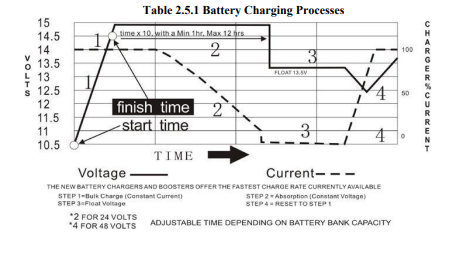

Use with Lithium Ion Battery Packs
Our inverter charger can work with various lithium batteries like LiFePO4, and LFP battery. Please check the battery specification to make sure the charging setting of the inverter suits your lithium battery charge voltage and cut-off voltages. If the charging setting of the inverter does t match your lithium battery, please email your requirements to sales@sungoldpower.com for customization.
De-sulphation
The de-sulphation cycle on switch position 8 is marked in red because this is a very dangerous setting if you do not know what you are doing. Before ever attempting to use this cycle you must clearly understand what it does and when and how you would use it.
What causes sulphation?
This can occur with infrequent use of the batteries(nor), or if the batteries have been left discharged so low that they will not accept a charge. This cycle is a very high voltage charge cycle designed to try to break down the sulfated crust that is preventing the plates from taking charge and thus allow the plates to clean up and so accept charge once again.
Charging depleted batteries
The LFP series inverter allows start-up and through power with depleted batteries. For the 12VDC model, after the battery voltage goes below 10V, if the switch is still (and always) kept in the “ON” position, the inverter is always connected to the battery, and the battery voltage does not drop below 2V, the inverter will be able to charge the battery once qualified AC inputs are present. Before the battery voltage goes below 9VDC, the charging can be activated when the switch is turned to “Off”, then to “ON”. When the voltage goes below 9VDC, and you accidentally turn the switch to OFF or disconnect the inverter from the battery, the inverter will not be able to charge the battery once again, because the CPU loses memory during this process.
The charging capacity will go to a peak in around 3 seconds. This may cause a generator to drop frequency, making the inverter transfer to battery mode. It is suggested to gradually put a charging load on the generator by switching the charging switch from min to max, together with the 15s switch delay, our inverter gives the generator enough time to spin up. This will depend on the size of the generator and the rate of charge.
Inverter
Topology
The LFP inverter/charger is built according to the following topology.
- Inverter: Full Bridge Topology.
- AC Charger: Isolate Boost Topology Because of high-efficiency Mosfets and 16bit, 4.9MHz microprocessor and heavy transformers, it outputs PURE SINE WAVE AC with an average THD of 10% (Min5%, Max 15%) depending on the load connected and battery voltage. The peak efficiency of the LFP series is 88%.
Overload Capacity
The LFP series inverters have different overload capacities, making them ideal to handle demanding loads.
- For 110%<Load<125%(±10%), no audible alarm in 14 minutes, beeps 0.5s every 1s in the 15th minute, and Fault(Turn off) after the 15th minute.
- For 125%<Load<150%(±10%), beeps 0.5s every 1s and Fault(Turn off) after the 1 minute. 3 For 300%≧Load>150%(±10%), beeps 0.5s every 1s and Fault(Turn off) after 20s.
Auto frequency adjust
The inverter has an Auto Frequency adjust function. The factory default configuration for 220/230/240VAC inverter is 50Hz, and 60Hz for 100/110/120VAC inverter. While the output freq can be easily changed once a qualified freq is applied to the inverter. If you want to get 60Hz from a 50Hz inverter, just input 60Hz power, and the inverter will automatically adjust the output freq to 60Hz and vice versa.
DIP Switches
On the rear panel of the inverter, 5 DIP switches enable users to customize the performance of the device.
SW1: Low Battery Trip Volt: For the 12VDC model, the Low Battery Trip Volt is set at 10.0Vdc by a typical deep cycle lead acid battery. It can be customized to 10.5Vdc using SW1 for a sealed car battery, this is to prevent batteries from over-discharging while there is only a small load applied on the inverter. (*2 for 24VDC, *4 for 48VDC)
SW2:AC Input Range: There are different acceptable AC input ranges for different kinds of loads. For some relatively sensitive electronic devices, a narrow input range of 184-253VAC (100-135V for the 120VAC model) is required to protect them. While for some resistive loads that work in a wide voltage range, the input AC range can be customized to 154-253VAC (90-135V for 120VAC model), this helps to power loads with the most AC input power without frequent switches to the battery bank.
SW3: Power Saver Auto Setting: The inverter is factory defaulted to detect load for 250ms every 30 seconds. This cycle can be customized to 3 seconds through the SW3 on the DIP switch.
SW4: Adjust 50hz/60hz The output frequency of the inverter can be set at either 50Hz or 60Hz by SW4.
SW5:Solar/AC Priority: Our inverter is designed with AC priority by default. This means, that when AC input is present, the battery will be charged first, and the inverter will transfer the input AC to power the load. Only when the AC input is stable for a continuous period of 15 days, the inverter will start a battery inverting cycle to protect the battery. After 1 cycle normal charging and AC throughput will be restored. The AC Priority and Battery Priority switch is SW5. When you choose battery priority, the inverter will invert from the battery despite the AC input. Only when the battery voltage reaches a low voltage alarm point(10.5V for 12V), does the inverter transfer to the AC Input, charge the battery, and switch back to the battery when the battery is charged full. This function is mainly for wind/solar systems taking utility power as backup.
Transfer
While in the Standby Mode, the AC input is continually monitored. Whenever AC power falls below the VAC Trip voltage (154 VAC, default setting for 230VAC,90VAC for 120VAC), the inverter automatically transfers back to the Invert Mode with minimum interruption to your appliances – as long as the inverter is turned on. The transfer from Standby mode to Inverter mode occurs in approximately 8 milliseconds. And it is the same time from Inverter mode to Standby mode. Though it is not designed as a computer UPS system, this transfer time is usually fast enough to keep your equipment powered up. There is a 15-second delay from the time the inverter senses that continuously qualified AC is present at the input terminals to when the transfer is made. This delay is built in to provide time for a generator to spin up to a stable voltage and avoid relay chattering. The inverter will not transfer to the generator until it has locked onto the generator’s output. This delay is also designed to avoid frequent switching when the input utility is unstable.
Power Saver Mode
- There are 3 different working statuses for the LFP inverters: “Power Saver Auto” 、“Power Saver Off” and “Power Off”.
- When the power switch is in the “Unit Off” position, the inverter is powered off.
- When the power switch is turned to either “Power Saver Auto” or “Power Saver Off”, the inverter is powered on.
- The power saver function is designed to conserve battery power when AC power is not or rarely required by the loads.
- In this mode, the inverter pulses the AC output looking for an AC load (i.e., electrical appliance). Whenever an AC load (greater than 25 watts) is turned on, the inverter recognizes the need for power and automatically starts inverting and the output goes to full voltage. When there is no load (or less than 25 watts) detected, the inverter automatically goes back into search mode to minimize energy consumption from the battery bank.
- In “Power saver on” mode, the inverter will draw power mainly in sensing moments, thus the idle consumption is significantly reduced.
- The inverter is factory defaulted to detect load for 250ms every 30 seconds. This cycle can be customized to 3 3-second turn SW3 on the DIP switch.

Note: The minimum power of load to take the inverter out of sleep mode (Power Saver On) is 25 Watts. When in the search sense mode, the green power LED will blink and the inverter will make a ticking sound. At full output voltage, the green power LED will light steadily and the inverter will make a steady humming sound. When the inverter is used as an “uninterruptible” power supply the search sense mode or “Power Saver On” function should be defeated. Exceptions
Some devices when scanned by the load sensor cannot be detected. Small fluorescent lights are the most common example. (Try altering the plug polarity by turning the plug over.) Some computers and sophisticated electronics have power supplies that do not present a load until line voltage is available. When this occurs, each unit waits for the other to begin. To drive these loads either a small companion load must be used to bring the inverter out of its search mode, or the inverter may be programmed to remain at full output voltage.
Protections
The LFP series inverter is equipped with extensive protection against various harsh situations/faults.
These protections include:
- AC Input over-voltage protection/AC Input low voltage protection
- Low battery alarm/High battery alarm
- Over temperature protection/Overload protection
- Short Circuit Protection (1s after fault)
- Back feeding protection
- When Over-temperature/Over load occurs, after the fault is cleared, the master switch has to be reset to restart the inverter.
- The Low battery voltage trip point can be customized from the defaulted value of 10VDC to 10.5VDC thru the SW1 on the DIP switch.
- The inverter will go to temp protection when the heat sink temp. ≥105ºC, and go to Fault (shutdown Output) after 30 seconds. The switch has to be reset to activate the inverter.
- The LFP series Inverter has back feeding protection which avoids presenting an AC voltage on the AC input terminal in Invert mode.
- After the reason for the fault is cleared, the inverter has to be reset to start working.
LED Indicator & LCD
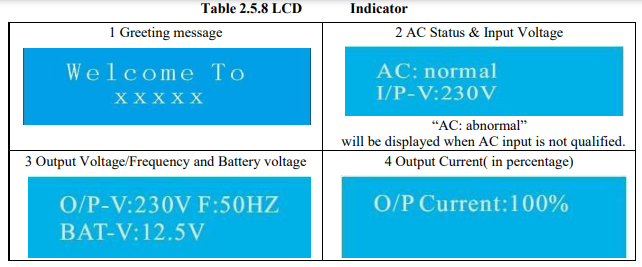
Automatic Voltage Regulation(Optional)
The automatic voltage regulation function is for the full series of LFP Pure Sine Wave Inverter/ Charger except for split phase models including LFP 1000W~6000W. Instead of simply bypassing the input AC to power the loads, the LFP series inverter stabilizes the input AC voltage to a range of 230V/120V±10%. Connected with batteries, the LFP Series inverter will function as a UPS with a max transfer time of 10 ms. With all the unique features our inverter provides, it will bring you long-term trouble-free operation beyond your expectations.
Function Introduction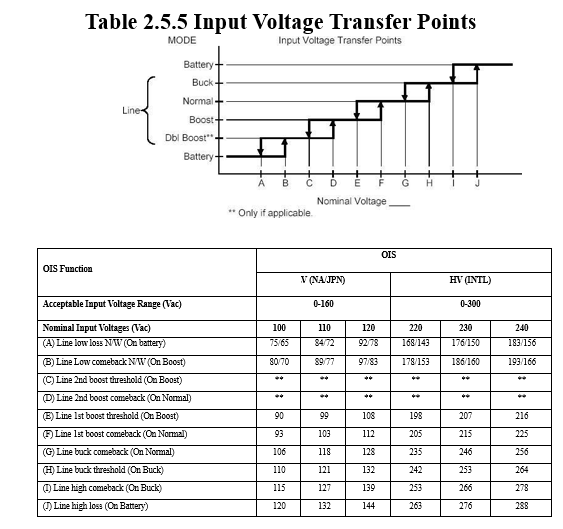
LCD Display Details
- Shore/ Generator voltage
- DC voltage on inverter
- Load when inverting %
- Low/high voltage, over temp, overload
- Fault condition
- AC Output voltage
- Output frequency
- Bypass (online) / inverter mode
- Battery state of charge graph
WARNING
Never cut the telephone cable when the cable is attached to the inverter and the battery is connected to the inverter. Even if the inverter is turned off. It will damage the remote PCB inside if the cable is short-circuited during cutting.
Audible Alarm
FAN Operation
For 1-3KW,4KW 24V/48V there is one multiple controlled DC fan which starts to work according to the following logic. For 4KW 12V and 6KW, there are two multiple controlled DC fans, the DC fan at the DC terminal side will work in the same way as the one on 1-3KW. So when the inverter is in power saver mode, the AC fan will work from time to time in response to the pulse sent by the inverter in power saver mode. The Operation of the DC fan at the DC terminal side is controlled by the following logic (Refer to Table 2.5.10):
Allow at least 30CM of clearance around the inverter for airflow. Make sure that the air can circulate freely around the unit. Variable speed fan operation is required in invert and charge mode. This is to be implemented in such a way as to ensure high reliability and safe unit and component operating temperatures in an operating ambient temperature of up to 50°C.
- Speed to be controlled smoothly as a function of internal temperature and/or current.
- The fan should not start/stop suddenly.
- The fan should run at the minimum speed needed to cool the unit—fan noise level target <60db at a distance of 1m.
Other features
Battery Temperature Sensing
- Applying the proper charge voltage is critical for achieving optimum battery performance and longevity.
- The ideal charge voltage required by batteries changes with battery temperature.
- The battery temperature sensor allows the charge controller to continuously adjust the charge voltage based on the actual battery temperature.
- Temperature compensation of charge voltage assures that the battery receives the proper charge voltage as battery temperature varies.
- The entire line is equipped with Battery Temperature Sensing for increased charging precision.
- It sends precise information to the charger, which automatically adjusts voltage to help ensure a full battery charge depending on the ambient temperature of your battery installation.
- When the battery voltage is over 40℃(104℉), it will reduce the charging voltage by 0.1Vdc with every degree of temperature rise.
- We recommend that you install Battery Temperature Sensors on all banks to protect your batteries and provide optimal charging for each bank.
- The battery temperature sensor mounts on the side of the battery. The specification is as below
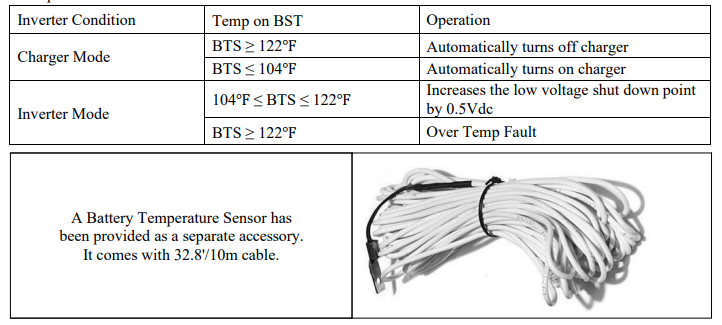
Battery voltage recovery start
After low battery voltage shut off (10V for 12V model/20V for 24V model/40V for 48V model), the inverter can restore operation after the battery voltage recovers to 13Vdc/26Vdc/52Vdc (with the power switch still in the “On” position). This function helps to save the users extra labor to reactivate the inverter when the low battery voltage returns to an acceptable range in renewable energy systems. The built-in battery charger will automatically reactivate as soon as the city/generator AC has been stable for 15 seconds.
WARNING
Never leave the loads unattended, some loads (like a Heater) may cause accidents in such cases. It is better to shut everything down after a low-voltage trip than to leave your load on, due to the risk of fire.
Auto Gen Start
- The inverter can be customized to start up a generator when the battery voltage goes low.
- When the inverter goes to a low battery alarm, it can send a signal to start a generator and turn the generator off after battery charging is finished. (Generator must have auto start function.)
- The auto-gen start feature will only work with generators designed to work with this feature. There is an open/close relay that will short-circuit the positive and negative cable from a generator. The input DC voltage can vary, but the maximum current the relay can carry is 16Amp.
Conformal Coating
The entire line of inverters has been processed with a conformal coating on the PCB, making it water, rust, and dust-resistant. While these units are designed to withstand corrosion from the salty air, they are not splashproof
Installation
Location
Follow all the local regulations to install the inverter. Please install the equipment in a location that is Dry, Clean, Cool and that has good ventilation.
- Working temperature: ‐10℃‐40℃
- Storage temperature: ‐40‐70℃
- Relative Humidity: 0%‐95%,
- Non-condensing cooling: Forced air
DC Wiring recommendation
It is suggested the battery bank be kept as close as possible to the inverter. The following table is a suggested wiring option for 3 3-meter DC cables. Please find the following minimum wire size. In case of a DC cable longer than 3m, please increase the cross-section of the cable to reduce the loss.
AC Wiring
We recommend using 10 to 6Awg wire to connect to the AC terminal block. When in AC mode the AC input power will supply both the loads and AC charger, a thicker wire gauge for AC Input is required. Please consult a qualified electrician about the specific wire gauge required in terms of wire material and inverter power. There are 3 different ways of connecting to the terminal block depending on the model. All the wirings are CE compliant, Call our tech support if you are not sure about how to wire any part of your inverter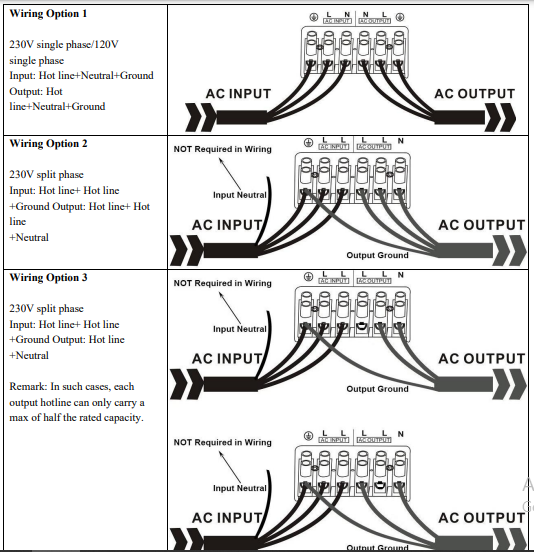
WARNING
For split phase models, AC input neutral is not required in wiring. Never Connect Input Neutral to Output Neutral. Damage will result which is not covered under warranty.
WARNING
The output voltage of this unit must never be connected to its input AC terminal, overload or damage may result. Always switch on the inverter before plugging in any appliance.
Grounding
Connect an AWG 8 gauge or greater copper wire between the grounding terminal on the inverter and the earth grounding system or the vehicle chassis.
Automatic Neutral-to-Ground Connection
All single-phase 120Vac inverters are equipped with an automatic neutral-to-ground switch. These inverters use an internal relay that automatically connects the AC neutral output to the vehicle/ship’s safety ground in inverter mode and cuts off when it is connected to a qualified external AC power source. This design avoids the simultaneous existence of two neutral-to-ground connections, avoiding the risk of shock hazard between the vehicle/boat’s neutral and the external AC source’s neutral.
Disabling the Automatic Neutral-to-Ground Connection
In some installations, this function must be disabled. To accommodate these situations, the automatic neutral-to-ground system can be defeated, so the neutral will not be bonded in any operating mode. If you are not sure whether you must disable this function, please refer to the local code requirements. There is a section of green wire with an insulated connector at the left side of the AC terminal block. The insulated connector connects the neutral wire and the ground wire inside the inverter during inverting. Pull two ends of the insulated connector apart to separate the green wire; this will prevent the neutral and ground wires from being connected to the inside of the inverter. If possible, please use tape to insulate the disconnected ends, separate the ends from each other, and push back out of the way. Typically when connecting to the house panel (after disconnecting city power from it), it is when you want to disconnect this connection as the house panel already has the neutral-to-ground bond. Normally in a standalone system or a vehicle, you need to maintain this connection.
Install Flange

Troubleshooting Guide
Troubleshooting contains information about how to troubleshoot possible error conditions while using the LFP Series Inverter and charger. The following chart is designed to help you quickly pinpoint the most common inverter failures.
Indicator and Buzzer For LFP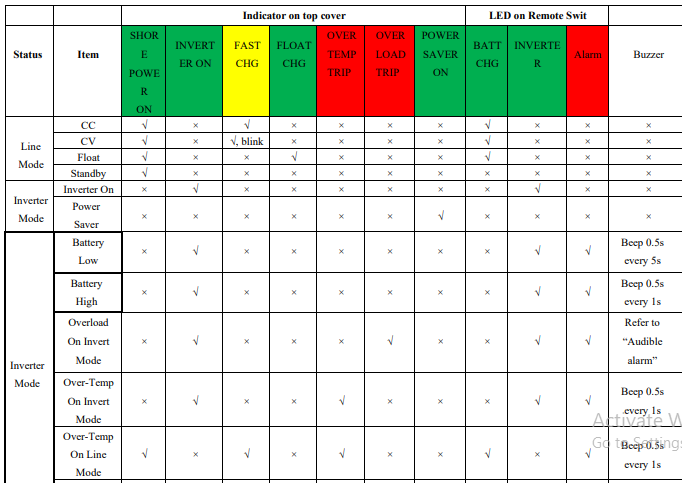

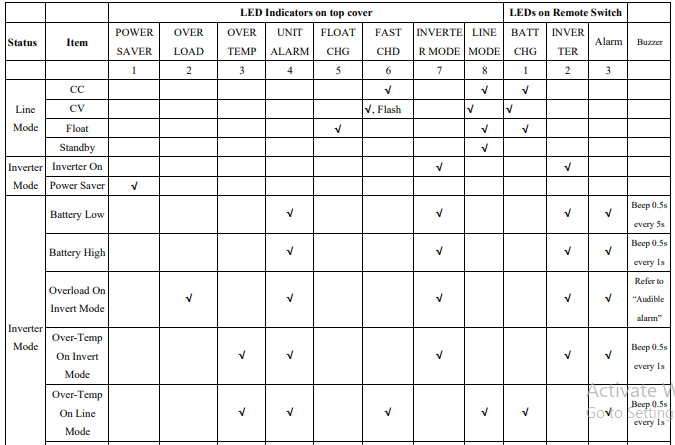


The reason for the noise from the transformer and/or case

When in inverter mode the transformer and/or case of the inverter sometimes may vibrate and make noise. The noise may come from the transformer. According to the characteristics of our inverter, there is one type of load that will most likely cause rattles in the transformer, that is a half-wave load, a load that uses only a half cycle of the power(see Figure 1). This trend causes an imbalance of the magnetic field of the transformer, reducing its rated working freq from 20KHz to, say, maybe 15KHz (it varies according to different loads). This way, the frequency of noise falls exactly into the range (200Hz-20KHz) that the human ear can sense. The most common load of such kind is hair drier.

Electrical Specifications
Inverter & AC Charger
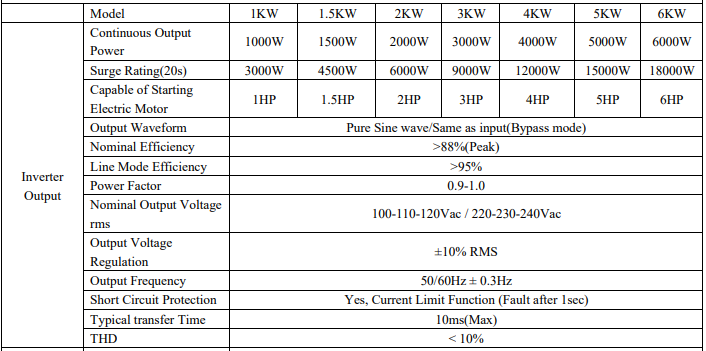
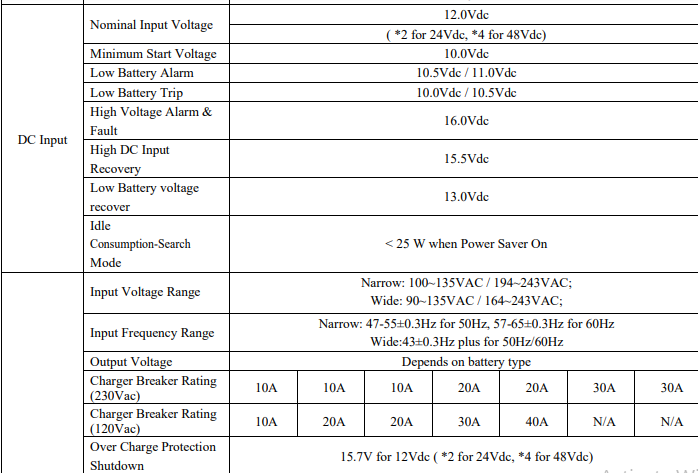

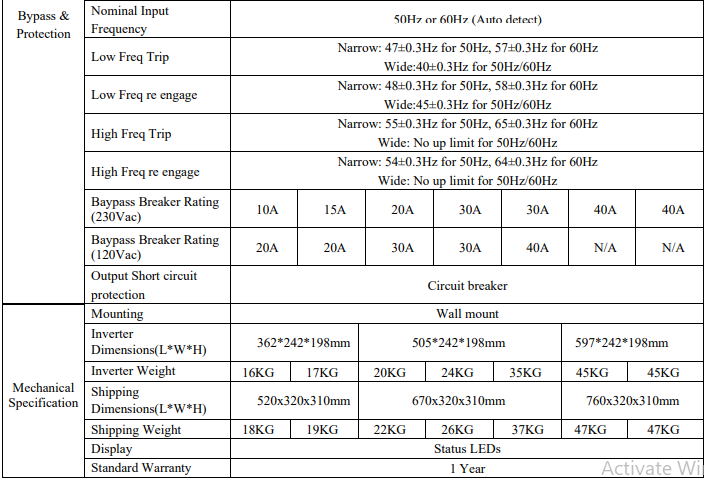
Installation Diagram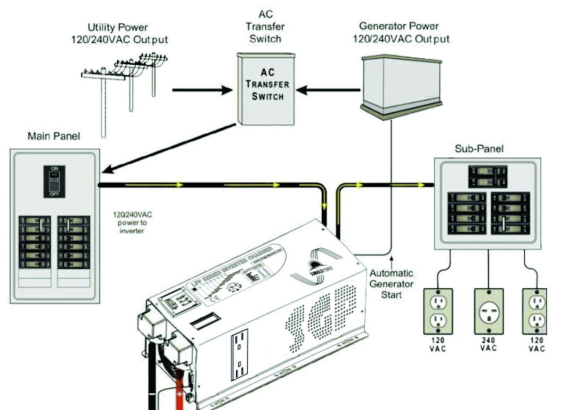

FAQS About SunGoldPower 3000W DC 12V Peak 9000W Inverter Charger
What is an inverter charger?
An inverter charger is a device that converts DC (direct current) power from a battery into AC (alternating current) power for running household appliances and electronics. Additionally, it often has a built-in charger to replenish the battery when an external AC power source is available.
What is the power rating of the SunGoldPower 3000W Inverter Charger?
Check the product specifications for the power rating. The 3000W rating likely refers to the inverter’s output capacity, while the 9000W peak power may indicate its ability to handle short-term power surges.
Can it be used with a 12V DC power source?
Verify that the inverter charger is compatible with a 12V DC power source, as mentioned in the product documentation.
What types of batteries are compatible?
Inverter chargers typically work with specific types of batteries. Confirm the compatible battery types and ensure your battery matches the requirements.
How does the charging function work?
Understand the charging process and options. Inverter chargers usually have settings for different charging modes, such as bulk, absorption, and float.
Are there built-in safety features?
Inverters should have safety features like overload protection, over-temperature protection, and short circuit protection. Familiarize yourself with these features.
What are the installation requirements?
Check the installation guidelines provided by the manufacturer. It’s important to follow the recommended procedures for safe and efficient operation.
Is there a warranty?
Find out about the warranty coverage for the inverter charger. This information is usually available in the product documentation or on the manufacturer’s website.
Can it be used for solar power systems?
Some inverter chargers are designed for use in solar power systems. Check if the SunGoldPower inverter charger is suitable for integration with solar panels.
What are the dimensions and weight?
Consider the physical size and weight of the inverter charger to ensure it fits in your intended installation space and can be easily handled.
For more manuals by SunGoldPower ManualsDock


